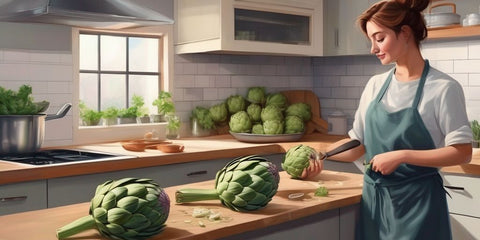Preparing Your Workspace and Tools
Setting Up a Clean Cutting Board
Start by cleaning your cutting board with soapy water and rinse thoroughly. A clean surface is crucial for precise cuts and to avoid cross-contamination.
Selecting the Right Knives
Choosing the right knives is essential for efficient and safe chicken carving. Invest in a quality knife set or quality kitchen knives that include a chef's knife and/or a boning knife. The sharpness and proper grip of these knives ensure that you can slice through the chicken with minimal effort and maximum control.
Arranging Plates and Serving Tools
Before you begin to carve, arrange all of your necessary plates and serving tools around your workspace. This helps to seamlessly transfer the carved pieces from the cutting board to the serving platter, making the process smooth and organized.
Understanding Chicken Anatomy
Carving a whole roasted chicken is an art, and having a fundamental understanding of its anatomy is key. Recognizing the key parts such as the breast, thighs, wings, and legs allows for more efficient and precise cuts. Each section of the chicken offers different textures and flavors. Knowing the exact locations of joints will enable you to cut through them with ease rather than hacking through a bone. This not only preserves the aesthetic of your servings but also ensures that the meat is cleanly separated. The skin should be kept intact as much as possible to maintain moisture and flavor. Using a sharp chef's knife and a bit of elbow grease should make carving a whole chicken a fairly simple task.
Step-by-Step Carving Guide
Removing the Legs and Thighs
Begin by placing your roasted chicken on a stable cutting board. Gently pull the leg away from the body and slice through the skin connecting that connects it. Find the joint and use your knife to cut through it, separating the leg and thigh from the body.
Slicing the Breast Meat
Once the legs are removed, you can focus on the breast. Start at the sternum and slice downward, following the rib cage. This technique ensures you get the most meat off the bone. The sharpness of your knife is crucial here to avoid shredding the meat.
Detaching the Wings and Final Touches
Finally, move to the wings. Hold the wing by the tip and slice through the joint where it connects to the body. This should be done smoothly to preserve the integrity of the wing. After the wings are detached, you can make any final trims or cuts to clean up the presentation of the chicken before serving.
Serving and Presentation Tips
Arranging the Meat on a Platter
After you have carved your chicken, you can now arrange the meat on a platter. The key is to place the pieces in a way that showcases the cuts and makes it easy for guests to select their preferred parts. Start by placing the larger pieces, like the breasts and thighs, at the center, and arrange the smaller pieces, like the wings and legs, around them. This layout not only looks appealing but also balances the platter visually. This is where the quality of your knife comes into play. A high quality chef knife will make the pieces of meat look cleaner and more visually pleasing.
Garnishing Your Carving
Garnishing will help the visual appeal of your dish. Simple, fresh ingredients can elevate the presentation significantly. Consider using herbs like parsley or cilantro, or even some spring onions for a touch of green that complements the golden-brown skin of the chicken. The brightness of the garnishes contrasts beautifully with the cooked meat, making the dish more inviting.
Suggested Side Dishes
Choosing the right side dishes can complement the main course and complete the meal. Opt for sides that balance the richness of the chicken, such as roasted vegetables, a light salad, or a creamy mashed potato. The sides should complement the flavors of the chicken but also add color and texture to the overall presentation.
Elevate your culinary skills and presentation with our expert tips on serving and presentation. Discover innovative ways to showcase your dishes that will impress your guests and enhance their dining experience. For more detailed guidance and inspiration, visit our website and explore our full range of articles and resources designed to help you become a master in the kitchen.



